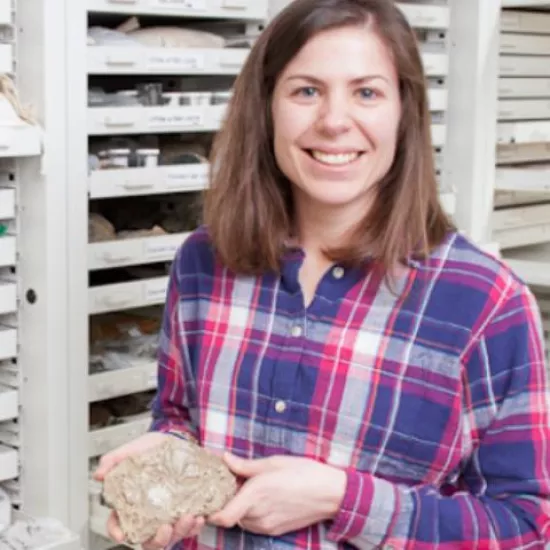
Jessica Slomka
-
E-mail:
-
Mailing Address:
3359 Mississauga Road
Mississauga ON L5L 1C6
Canada
Research Areas:
Earth Science research:
Glacial sedimentology, sedimentary architecture, modern and ancient glacial deposits, modern glacial forelands, application of sedimentary architecture to groundwater and aggregate resources.
Pedagogical research:
Development and implementation of interdisciplinary science courses.
Research Profile:
Earth Science is my passion and teaching is my vocation. I believe that teaching is most effective when learning involves creativity, passion and enthusiasm for the subject, and synergy involving collaboration among students, faculty, and the community. The Earth Sciences is a highly interdisciplinary field that requires the integration of knowledge from across the science disciplines and awareness of sociopolitical and economic influences. My pedagogical research focuses on the development and implementation of interdisciplinary science courses at the secondary and post-secondary level, including academic achievement of students in interdisciplinary versus discipline-specific science courses and the barriers and challenges faced by educators and students when developing and implementing these courses. My experiences with developing and teaching in the iSci program at McMaster University has provided first-hand insight into the process of building an undergraduate interdisciplinary science program.
Glacial sediments commonly form the youngest geological layer across North America. Glacial sediments are often viewed as ‘messy’ and ‘highly heterogenous’, and lumped into a unit referred to as ‘overburden’ or ‘drift’ for various geotechnical applications. Glacial sediments host several important resources including groundwater and aggregate and may contain migration pathways for contaminants and hydrocarbons; hence, knowledge of the sedimentary architecture, including the facies and geometry of glacial units, is important to understand and predict resource potential and fluid migration pathways. My Ph.D. research (McMaster University) focuses on applying the method of architectural element analysis (AEA) to delineate the sedimentary architecture of glacial sediments to understand sediment transport processes involved in the deposition of till and subglacial outwash sediments (‘Tiskilwa till’; Illinois, USA), assess the interconnectivity of coarse- and fine-grained units at various scales with application to groundwater resources (Georgetown, ON, Canada), and reconstruct the evolution of a glacial foreland as a result of ice margin advance/retreat and jökulhlaups by integrating a landsystems approach (Sólheimajökull, Iceland). In collaboration with a geomodeller (K.E. MacCormack), I explore methods that help to preserve high-quality (often clustered) geological data in regional-scale datasets for 3D geological modeling of glaciated terrains (Halton Region, ON, Canada). My work at the Alberta Geological Survey (2014-2017) focused on understanding the glacial stratigraphy and depositional history of the Peace River area (Alberta, Canada), including assessment of the sedimentary record and evolution of glacial lakes impounded in the Peace River lowland and understanding the depositional history and architecture of the Grimshaw Gravels.
Publications:
Slomka, J.M. (2019). Analysing the nature of Ministry guidelines for developing interdisciplinary science courses (Grades 11-12) in Ontario (Canada). Canadian Journal of Science, Mathematics, and Technology Education, 1-20, DOI 10.1007/s42330-019-00062-w
Slomka, J.M., MacCormack, K.E., and Eyles, C.H. (2019). Preservation of local high-resolution data in a regional low-resolution dataset: A ‘nested’ 3D modeling approach using an example from a Quaternary glacial stratigraphy (Ontario, Canada). Engineering Geology, v. 248, 309-329.
Slomka, J.M. and Hartman, G.M.D. (2019). Sedimentary architecture of a glaciolacustrine braidplain delta: proxy evidence of a pre-Middle Wisconsinan glaciation (Grimshaw gravels, Interior Plains, Canada). Boreas, v. 48, 215-235.
Slomka, J.M. (2018). Cenozoic stratigraphy of northwestern Alberta (parts of NTS 83M-O and 84B-G); Alberta Energy Regulator, AER/AGS Open File Report 2018-05, 74 p. Available at: https://ags.aer.ca/publications/OFR_2018_05.html#summary
Slomka, J.M. and Utting, D. (2018). Glacial advance, occupation and retreat sediments associated with multi-stage ice-dammed lakes: north-central Alberta, Canada. Boreas, v. 47, 150-174.
Slomka, J.M., Hartman, G.M.D., and Klassen, J. (2018). Architecture and geometry of basal sand and gravel deposits, including the ‘Grimshaw gravels’, northwestern Alberta (NTS 84C and 84D); Alberta Energy Regulator, AER/AGS Open File Report 2018-04, 44 p. Available at: https://ags.aer.ca/document/OFR/OFR_2018_04.pdf
Slomka, J.M. and Eyles, C.H. (2015). Architectural-landsystem analysis of a modern glacial landscape, Sólheimajökull, southern Iceland. Geomorphology, v. 230, p. 75-97.
Slomka, J.M., Eyles, C.H., Mulligan, R.P.M., McKay, III, D.E., Berg, R.C. (2015). Internal architecture of a till sheet, Tiskilwa Formation, north-central Illinois, USA: Application of architectural element analysis. Sedimentology, v. 62, p. 1328-1359.
Slomka, J.M. and Eyles, C.H. (2013). Characterizing heterogeneity in a glaciofluvial deposit using architectural elements, Limehouse, Ontario, Canada. Canadian Journal of Earth Sciences, v. 50, p. 1-19. (Selected as CJES Editor’s Choice)
